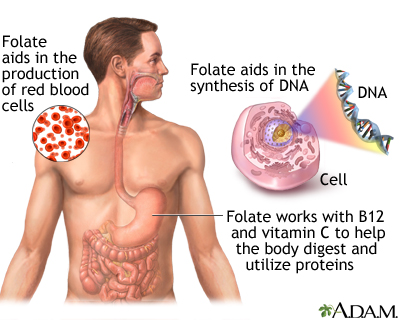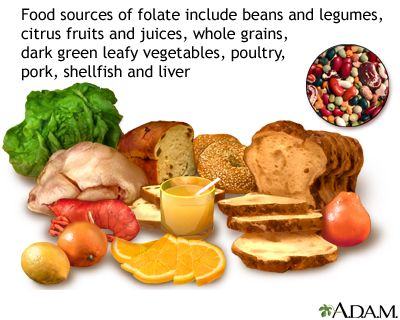Folic acid in diet
Folic acid; Polyglutamyl folacin; Pteroylmonoglutamate; Folate; Folate polyglutamates; Folinic acid; Leucovorin
Folic acid and folate are both terms for a type of B vitamin (vitamin B9). The terms folic acid and folate are often used interchangeably.
Folate is a B vitamin that occurs naturally in foods such as green leafy vegetables, citrus fruit, and beans.
Folic acid is man-made (synthetic) folate. It is found in supplements and added to fortified foods.
Folic acid is water-soluble. Leftover amounts of the vitamin leave the body through the urine. That means your body does not store folic acid. You need to get a regular supply of the vitamin through the foods you eat or through supplements.

Folate (folic acid) is necessary for the production of red blood cells and for the synthesis of DNA (which controls heredity and is used to guide the cell in its daily activities). Folic acid also helps with tissue growth and cell function. In addition, it helps to increase appetite when needed and stimulates the formation of digestive acids.

Women who are thinking of becoming pregnant or who are pregnant often require additional supplementation of folic acid. Adequate folic acid is important for pregnant women because it has been shown to prevent some kinds of birth defects, including neural tube defects such as spina bifida. Many foods are now fortified with folic acid to help prevent these kinds of serious birth defects.
Function
Folate has many functions in the body:
- Helps tissues grow and cells work
- Works with vitamin B12 and vitamin C to help the body break down, use, and create new proteins
- Helps form red blood cells (helps prevent anemia)
- Helps produce DNA, the building block of the human body, which carries genetic information
Folate deficiency may cause:
- Diarrhea
- Gray hair
- Mouth ulcers
- Peptic ulcer
- Poor growth
- Swollen tongue (glossitis)
It may also lead to certain types of anemia.
Because it may be hard to get enough folate through foods, women thinking about becoming pregnant should take folic acid supplements. Taking the right amount of folic acid before and during pregnancy helps prevent a type of birth defect called neural tube defects, including spina bifida. Taking higher doses of folic acid before you get pregnant and during the first trimester may lower your chances of miscarriage.
Food Sources
Folate occurs naturally in the following foods:
- Dark green leafy vegetables
- Dried beans and peas (legumes)
- Citrus fruits and juices
Fortified means that vitamins have been added to the food. Many foods are now fortified with folic acid. Some of these are:
- Enriched breads
- Cereals
- Flours
- Cornmeals
- Pastas
- Rice
- Other grain products
There are also many pregnancy-specific products on the market that have been fortified with folic acid. Some of these provide folic acid at levels that meet or exceed the doses recommended below. Taking more is not needed and does not provide any added benefit. The recommended doses are based on folic acid that comes from supplements and fortified foods. It does not refer to the folate found naturally in foods.
Side Effects
Folic acid does not cause harm when used at recommended levels. Folic acid dissolves in water. This means that it is regularly removed from the body through urine, so excess amounts do not build up in the body.
Except for women with a history of pregnancy affected by a neural tube defect who are planning to become pregnant, you should avoid taking more than 1,000 mcg per day of folic acid. Although the risk is low, using higher levels of folic acid can mask vitamin B12 deficiency. Check with your health care provider for the best dose for you.
Recommendations
The best way to get the daily requirement of essential vitamins is to eat a wide variety of foods. Most people in the United States get enough folic acid in their diet because there is plenty of it in the food supply.
Folic acid can help reduce the risk for certain birth defects, such as spina bifida and anencephaly.
- Women who are of childbearing age should take at least 400 micrograms (mcg) of a folic acid supplement every day in addition to that found in fortified foods.
- Pregnant women should take 600 micrograms a day, or 1000 micrograms a day if expecting twins.
The Recommended Dietary Allowance (RDA) for vitamins reflects how much of each vitamin most people should get each day.
- The RDA for vitamins may be used as goals for each person.
- How much of each vitamin you need depends on your age and sex. Other factors, such as pregnancy and illnesses, are also important.
The Food and Nutrition Board of the National Academies of Sciences, Engineering, and Medicine Recommended Intakes for Individuals - Daily Reference Intakes (DRIs) for folate:
Infants
- 0 to 6 months: 65 mcg/day*
- 7 to 12 months: 80 mcg/day*
*For infants from birth to 12 months, the Food and Nutrition Board established an Acceptable Intake (AI) for folate that is equivalent to the mean intake of folate in healthy, breastfed infants in the United States.
Children
- 1 to 3 years: 150 mcg/day
- 4 to 8 years: 200 mcg/day
- 9 to 13 years: 300 mcg/day
Adolescents and adults
- Males, age 14 and older: 400 mcg/day
- Females, age 14 and older: 400 mcg/day
- Pregnant females of all ages: 600 mcg/day
- Females with a history of pregnancy affected by a neural tube defect: 4,000 mcg/day when planning pregnancy and during the first trimester of pregnancy
- Breastfeeding females of all ages: 500 mcg/day
References
Bodnar LM, Himes KP. Maternal nutrition. In: Lockwood CJ, Copel JA, Dugoff L, et al, eds. Creasy and Resnik's Maternal-Fetal Medicine: Principles and Practice. 9th ed. Philadelphia, PA: Elsevier; 2023:chap 12.
Cooney J, Neild P. Diet and nutrition. In: Syndercombe Court D, Kadri A, Xiu P, eds. Medical Sciences. 4th ed. Philadelphia, PA: Elsevier; 2025:chap 16.
Mason JB, Booth SL. Vitamins, trace minerals, and other micronutrients. In: Goldman L, Cooney KA, eds. Goldman-Cecil Medicine. 27th ed. Philadelphia, PA: Elsevier; 2024:chap 199.
Snetselaar LG, de Jesus JM, DeSilva DM, Stoody EE. Dietary guidelines for Americans, 2020-2025: understanding the scientific process, guidelines, and key recommendations. Nutr Today. 2021;56(6):287-295. PMID: 34987271
The American College of Obstetricians and Gynecologists website. Nutrition during pregnancy.
Version Info
Last reviewed on: 2/3/2025
Reviewed by: Peter J. Chen, MD, FACOG, Associate Professor of OBGYN at Cooper Medical School at Rowan University, Camden, NJ. Review provided by VeriMed Healthcare Network. Also reviewed by David C. Dugdale, MD, Medical Director, Brenda Conaway, Editorial Director, and the A.D.A.M. Editorial team.
